La Basse Cour: B&B near Alencon, Normandy
Normandy B & B : Second World War
Ancinnes Resistance and Liberation in the Second World War
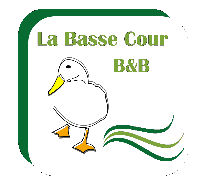
Ancinnes in the Second World War
1. The Resistance in Ancinnes
2. The Liberation of Ancinnes 11 August 1944
3. Bibliography
1. The Resistance in Ancinnes
THE STORY OF THE ANCINNES RESISTANCE GROUP AND THE PARACHUTE DROP OF JUNE 1943
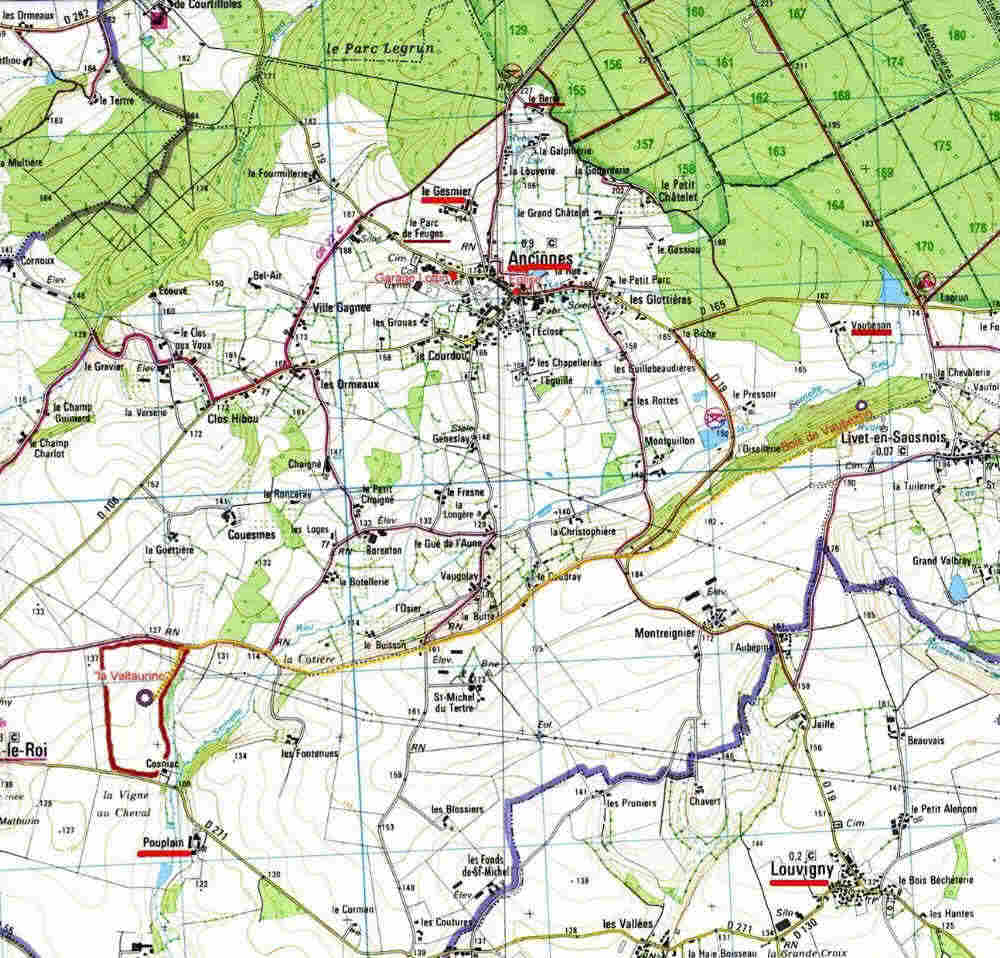
Map of key locations for the Ancinnes Resistance parachute drop
- "la Valtaurine" - the drop zone for 14-15 June 1943
- "la Garenne" in the "Bois de Vaubezon" - hiding place to which the arms were transported
- "Vaubezon" - the farm of Comte Arthur de Montalembert
The French Section of the Special Operations Executive (SOE) was run from London under the command of Colonel Buckmaster. Major Francis Suttill was one of several British officers who were sent into occupied France to set up resistance groups and subsequently supply arms and ammunition via RAF parachute drops ("parachutages"). The area for which Major Suttill was responsible stretched from Nantes in the south to the Ardennes in the north and east-west from Beauvais to Sologne. Major Suttill's code name was "Prosper" and his cover identity François Desprées, a sales rep. He organized some 70 parachute drops to resistance groups throughout his area.
Major Francis Suttill in uniform and as pictured on a French ID card in 1943
Reproduced with permission of Francis Suttill, son of Major Suttill
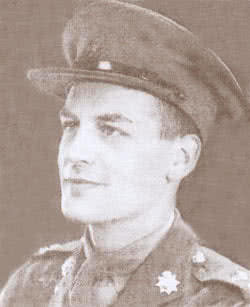

The Resistance group in the Sarthe around Le Mans was known as "Satirist Physician" and it was to this that the Ancinnes resistance members belonged. Major Suttill gave responsibility for organising the Satirist resistance groups to a French speaking Mauritian agent of British nationality called Joseph France Antelme.
A local landowner, Comte Arthur de Montalembert, was recruited to form the Ancinnes group. Montalembert lived on his family property and farm "Vaubezon", which lies to the east of Ancinnes, near the forest and the Etang de Vaubezon on the road to Neufchatel. The resistance group at Ancinnes was put together in early 1943 and comprised de Montalembert himself, Paul Lottin (mechanic and farrier), André Malo (farm hand) Paul Drecq (village postmaster) and Abbé Luçon (the village priest, recently arrived).
Abbé Luçon had been a resistance member for some considerable time before the rest of the group, having joined the Le Mans resistance in January 1941 and having encouraged youth club members during his time in Le Mans to join the resistance movement. He made contact with the Ancinnes group in February 1943.
A French resistance agent called Octave Simon worked with Major Suttill to organise parachute drops; he had previously been part of the resistance group "Autogiro" until its collapse in 1942. Simon was a sculptor and seems to have contacts with many land owning families of the northern Sarthe. Simon communicated with SOE London via Major Suttill's wireless operator, Gilbert Norman.
A parachute drop was organised for Ancinnes for the night of 14-15 June 1943. The radio code message transmitted by the BBC to alert the Ancinnes group of the impending drop was "Elle est bleue aux fleurs rouge", meaning "It is blue with red flowers".
The drop zone (DZ) was arranged on a parcel of land called "la Valtaurine", near the farm "Pouplain". The DZ would probably have been selected by Simon and would have been approved by either Major Suttill or Antelme.
The DZ "La Valtaurine" in August 2007 - the hedge marks the ditch where the containers were temporarily hidden

2 tons of arms and explosives and a radio transmitter were dropped by parachute at 23.00h, 14th June 1943, a warm and clear night. Ten containers were dropped in total and collected by Montalembert, Lottin, Drecq and Malo, assisted by Cellier, the head of another resistance group based at la Quinte near Le Mans. Some of the drop was immediately transported to a plot of land in the Bois de Vaubezon called "la Garenne" while the rest was hidden in a ditch to be moved over the following nights, taking until 25th June to complete the job. The containers were transported using a cow wagon owned by a Mr Drouin of Louvigny and drawn by a horse owned by a Mr Larpent, the Mayor of Livet. These men and the resistance members were rewarded by sweets, coffee and cigarettes - precious treats in time of rationing - included in the parachutage containers.
"La Garenne" in August 2007 - the road from the Passe Vite to Livet used to follow the edge of the woods;
directly ahead is the point below which the arms were hidden in a shallow cave

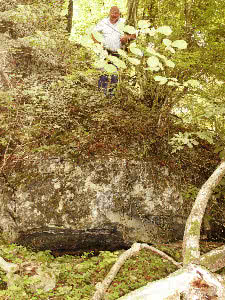

The cave on "la Garenne" in the "Bois de Vaubezon" where the arms were hidden awaiting collection; taken in August 2007 - the cave entrance has been largely blocked by earth and debris
The radio transmitter was taken to be set up in the farm of the Compte de Montalembert at "le Vaubezon", in the tower of a farm building (unfortunately now demolished).
Despite wounds
"Le Vaubezon" - the tower where the radio transmitter was installed following the parachute drop
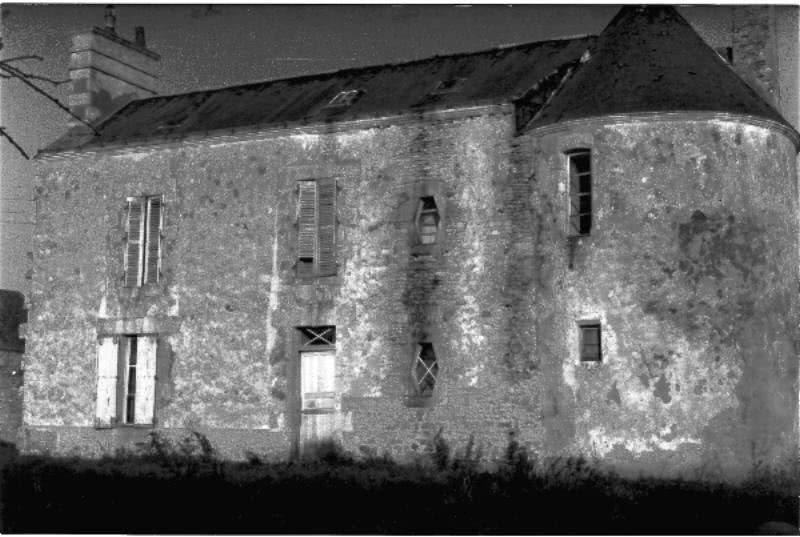
The weapons and material dropped at Ancinnes were destined for the Falaise resistance group, not for use in or near Ancinnes itself. 300kg of the drop was collected by two Falaise resistance members, Cauchy and Leroy, on the night of 25-26th June, shortly after the arrest of Suttill and Norman. Jean-Michel Cauchy, aka Paul of Falaise, aka Paul Sapin, was the leader of the Falaise group. The two Falaise men were due to collect the rest of the arms from Ancinnes on 2nd July but were arrested the day before, so the second collection never took place.
On 27th June Lottin, the mechanic, transported three parts of one container (they broke into pieces for ease of transport) to his home, where he hid them in his woodshed.
On 9th July 1943, a week after the arrest of the Falaise resistance members, two Gestapo (according to André Malo's account) or Military Policemen ("Feldgendarmerie", according to the official Mamers police report) arrived in a car with a third person - "un civil" according to the police report - to raid the homes of the Ancinnes resistance members Lottin, Malo and Drecq.
One theory has it that this third person might have been the leader of the Falaise group, Cauchy, and that he had been forced to name the Ancinnes group under interrogation. However, this idea seems largely based on rumour and supposition rather than fact. An alternative theory is that the group was betrayed by a certain René Rollet, a business rival of Lottin, but it is very unlikely that it was Rollet in the car. Rollet would be tried after the liberation for twice betraying Lottin, not only on this occasion but also via an anonymous letter to the German authorities in 1942. Because of that letter Lottin and his employee André Vovard had been arrested on 19th December 1942 for spreading anti-German propaganda, being released from prison at the end of January 1943. A third possibility is that this "civil" was a non-military police officer or a plain clothes officer ("gendarme en civil") rather than a civilian.
The house and workplace of Paul Lottin was the first to be raided and he was arrested in his garage workshop. A search of his premises revealed the three containers from the parachutage hidden in his woodshed. He was subsequently deported to Buchenwald on 29th October 1943 and executed in a gas chamber in Lublin (Poland) on 8 March 1944.
André Malo heard a car pull up outside "le Parc aux Feuges", the home of M. Mme Poupard where he was lodging, and realising it was a raid he took his chance to escape. He was spotted by the German police, who had Lottin with them, and ordered to surrender but he fled across fields and they opened fire on him. He escaped uninjured and hid in a ditch, then later in the evening made his way to M Mme André Pate's house, "Le Gesmier". This is a farmhouse off the route forestière not far from Ancinnes village centre. The Pates went to M Poupard's and got fresh clothes for Malo. He was later helped to avoid capture by several families in the surrounding villages who gave him shelter.
"Eglise St Pierre, St Paul" - the chuch where Drecq hid in the bell tower
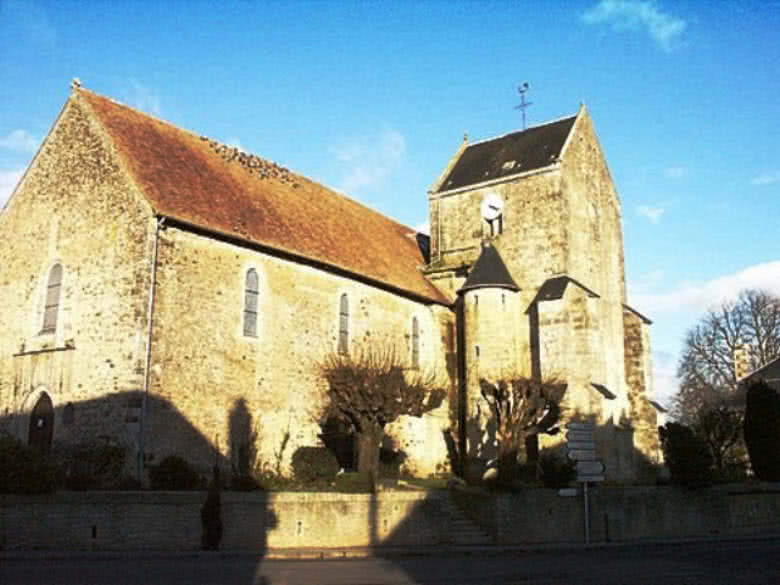
Paul Drecq had time to escape out of the back of his house thanks to his wife delaying the Feldgendarmerie at his front door; he then hid in the bell tower of the church St Pierre St Paul with the help of Abbé Luçon for several days. The abbé later helped Drecq to obtain false papers and make good his escape from the German authorities.
Arthur de Montalembert was not at home at "Vaubezon" on the day of the raid, being away in Paris on business, but was subsequently arrested at a friend's home in Le Mans on 5 October 1943. They were deported to the concentration camp at Mauthausen where de Montalembert died on 17 December 1944.
The Abbé Luçon, having helped Drecq to hide in the church, made contact with Cellier's resistance group at la Quinte and then another group based at the gendarmerie of Coulans, who helped him to deliver false papers to Drecq. He later joined the Mamers resistance group and took part in various dangerous missions - theft of German weapons, sabotage of telephone lines and other missions. He also crossed "No-Mans Land" to deliver information to the French forces concerning German defence positions around Ancinnes during the liberation battle of 11th August 1944.
André Malo and Paul Drecq returned to the village just after the liberation of 11 August 1944. After the war Malo ran the grocery store in Ancinnes and later became mayor. His wife was also sister of another resistance member, Aimé Tessier, a member of the maquis.
Following the liberation of the village in 1944 Rollet was tied to a post outside the village where he had insults thrown at him and he was terribly beaten by angry villagers. He was saved from worse - a possible lynching - by the intervention of the Abbé Luçon. He was handed over to the proper authorities and subsequently tried for betraying Lottin: there were two charges, one for reporting Lottin for anti-Nazi propaganda in 1942, the second for the betrayal after the parachute drop. The first charge was proved but the second was not, according to a report in "Le Maine Libre" newspaper of December 14 1945. Rollet was sentenced to 7 years imprisonment and a 20 years "interdiction de séjour" banning order, meaning he could not reside in the area. On his release from prison he moved to Angers where he died at the age of 81.
In his statement made in 1994, 50 years after the events described, André Malo says that another drop was planned for between 7-10 July 1943 but was cancelled due to the Gestapo raid on Ancinnes on 9th July.
The End of the Prosper Resistance Group
During the summer of 1943 it became clear that a double-agent had infiltrated the Special Operations Executive. Several agents, including Francis Cammaerts, Jack Agazarian and Francis Suttill became convinced that an SOE agent called Henri Déricourt was the man responsible. However, service chiefs were not convinced and refused to recall Déricourt to Britain.
In June and July 1943 hundreds of French agents in the Prosper group were arrested by the Germans, leading to the group's collapse. On 24 June 1943 Francis Suttill and Norman were themselves captured by the Gestapo and interrogated over several days.
Norman is alleged to have co-operated and even helped in the interrogation of the others captured. Regardless, Norman was subsequently sent to Mauthausen concentration camp where he was executed on the 6th September, 1944. Major Suttill was executed on 23 March 1945 at Sachsenhausen.
That the group had been infiltrated is evinced by the fact that Joseph France Antelme was parachuted directly into a German trap near Daon, Mayenne, on 29 February 1944. The unfortunate Antelme was subsequently executed in Gross-Rosen concentration camp on 12 September 1944.
Octave Simon escaped the round-up in 1943 and managed to reach London. He was trained by SOE only to be dropped, like Antelme, straight into a German trap at Sainville, 33 km E Chartres, on 7 March 1944. He died in Gros Rosen concentration camp on 1 August 1944.
The Liberation of Ancinnes – 11th August 1944
The Second French Armoured Division (2ème Division Blindée or "2DB") under the command of General Leclerc began disembarking on the night of 31 July 1944; the 2DB formed part of III US Army of General Patton, being incorporated into the 5th US Armour Division and the 79th US Infantry Division, forming the 15th Army Corps under the command of General Haislip.

After seeing action at Granville, the French 2DB reached Le Mans on the 9th August 1944, shortly after the city had been liberated by the American army.
On the 10th of August the French 2DB, with the American army on its right flank, headed due north from Le Mans towards Alençon. This manoeuvre was designed to cut off the German army near Falaise and Argentan (north of Alençon) as it retreated eastward from the Normandy coastline. Several hundred thousand German soldiers would eventually be encircled and captured in that area, known as the “Falaise Pocket”.
A series of skirmishes, many fierce and bloody, took place between the Allied armies advancing northwards and the German rearguard who were attempting to delay the Allies and buy time for their comrades as they retreated eastwards.
Ancinnes occupied an important strategic position for the German army, being next to the Perseigne Forest where a large contingent of German tanks were stationed in reserve and important ammunition dumps were hidden, and occupying a position with clear views across the countryside to the south. Accordingly, observation posts were located around Ancinnes to give advance warning to the German command of any approaching Allied activity, on the ground or in the air. A German Command post was stationed in Ancinnes, with personnel billeted in houses requisitioned from the villagers.
From early July, German armoured divisions had taken up defensive positions in several villages bordering the Perseigne Forest, including Ancinnes.
On the 11th and 12th August 1944 some 300 German tanks and other armour moved from the Perseigne Forest to take up positions north of Alençon, in the forest of Ecouves. On the morning of 11th August German Engineers also began to destroy the ammunition dumps in the forest of Perseigne.
The morning of 11th August 1944, units of the French 2DB, Infantry of the R.M.T and Engineers advanced towards Ancinnes and Louvigny from the neighbouring village of Rouessé-Fontaine. German tanks emerged from the forest and took up defensive positions on the roads leading into Ancinnes. These were reinforced by further German tanks, half tracks and armoured cars towards midday. By the end of the morning, a dozen or so German medium tanks and armoured gun carriers were circulating in the village centre and taking up defensive positions, together with 5 or 6 heavy tanks and more medium tanks on the village outskirts. By early afternoon these were in position to the south and south east of the village, hidden in the hedges and woods along the hillsides, awaiting the arrival of the advancing 2DB. At about the same time an American observation plane, flying over the area, opened fire and destroyed a German fuel tanker near “l’Oisellerie” on the D19.
German Defensive Positions and the Route of the 2.D.B.to Ancinnes (AXE “C”)
Tank or armoured gun defences were set up in and around Ancinnes at these points:
- In the village centre at “Le Chesnay”, where the road to Rouessé-Fontaine and Ancinette joins the D106 to Bourg le Roi.
- On the edge of the village at “Le Gesmier”, just off the forest road, close to the forest edge.
- to the south east, near the farm “le Pressoir”.
- On the D19 north east of Ancinnes leading to Alençon, near “le parc des Feuges”
- Along the road at the north end of the village, leading to “Ville Gagnée” and “Les Ormeaux”.
- In the “Bois de Navrotte”, the wood at the end of the Passe-Vite dirt track which runs along the hill crest south-east of Ancinnes to join the D19.
- In the valley along the Semelle river, near the farm called “Montguillon”, below the “Bois de Navrotte”.
- Other machine gun positions were located throughout the lanes and hedgerows leading into Ancinnes.
Key Events During the Liberation of Ancinnes, 11 August 1944
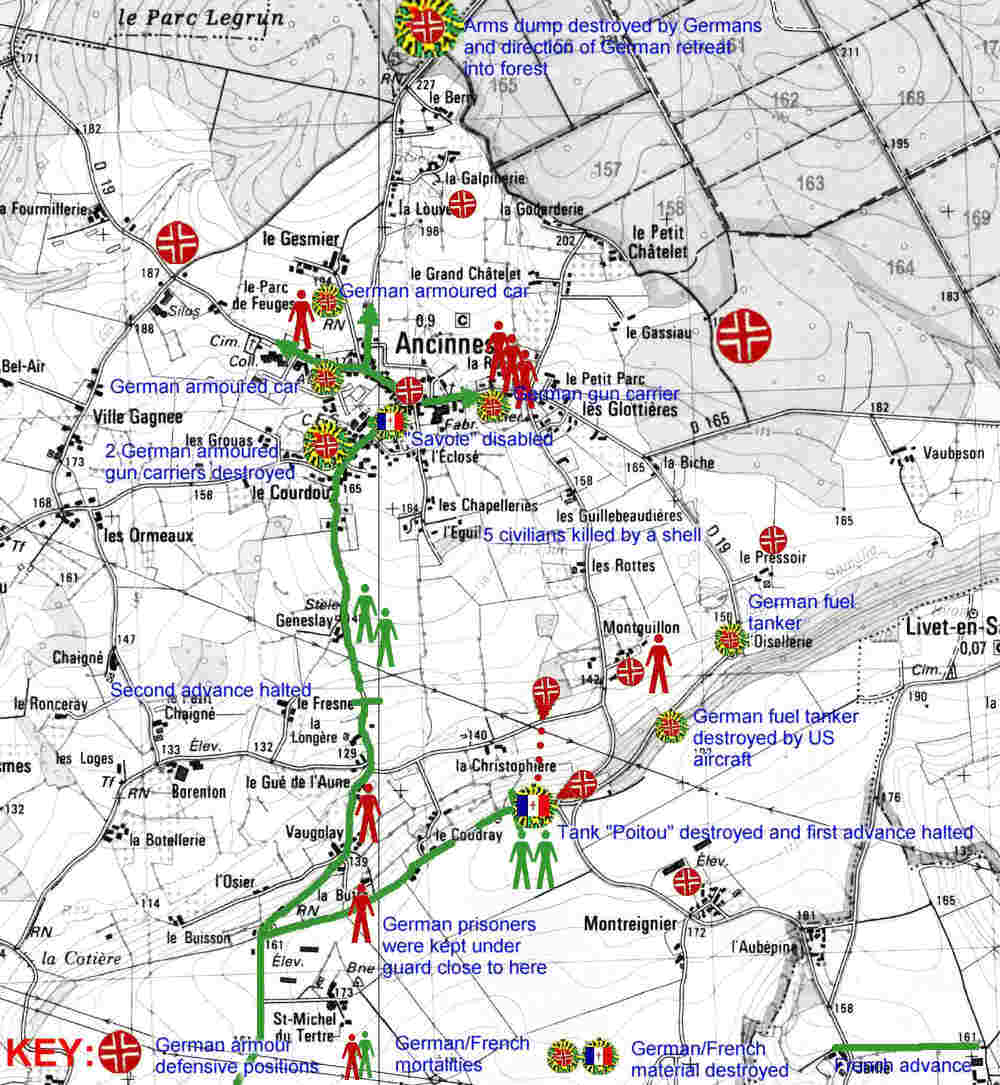
Early on the afternoon of 11th August 1944, a column of the 2DB arrived at the southern outskirts of Ancinnes in the form of three tank platoons (Cadillac M-5A1 light "Stuart" tanks and M3 medium "Sherman" tanks) from the 12th R.C.A. (Régiment de Chasseurs d'Afrique) and elements of the 5th and 6th Companies of the 2nd Battalion of the R.M.T. mobile infantry (Régiment de Marche du TChad) commanded by Captain Langlois de Bazillac.
"Stuart" M5A1 Tank

M3 Sherman Tank
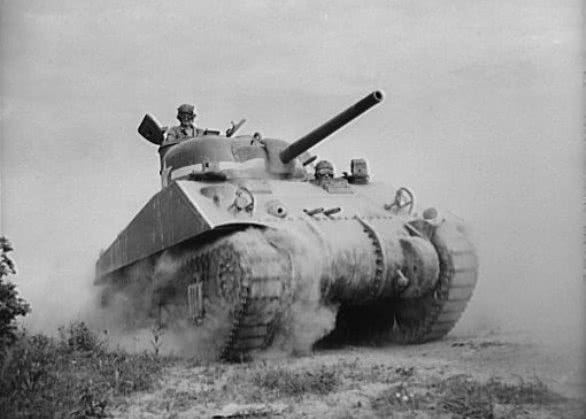
The column was under the command of Captain Rogier, acting on the orders of Cdt Jacques Massu.
They approached Ancinnes via the road from Ancinette, having earlier in the day seen fierce action near Rouessé-Fontaine, during which the light tank “Berry” had been destroyed with the loss of two crew members. Another armoured column simultaneously approached Louvigny to the east of Ancinnes.
The first skirmish took place at 15.30h when an advance party of French infantry came under fire from German machine guns positioned behind hedges at the crossroads with the track called the “Passe Vite”, just after the farm “St Michel du Tertre”.
The French brought their tanks forward and directed one platoon of tanks to turn right at the junction and traverse the hill crest above Ancinnes via the “Passe Vite” to the south east of the village; the intention was then to join the D19 and enter Ancinnes from the east. The “Passe Vite” at that time was a narrow dirt track (now tarmac) running along the hill crest, with a steep drop on the Ancinnes side and an earth bank one metre high on the other. They chose this route rather than trying to cross the open countryside of the plateau east of Ancinnes because the other column of the 2DB, which had already reached Louvigny to the immediate east, reported heavy German armour concealed on the plateau.
A platoon of three light (Cadillac M-5A1) tanks were sent along the “Passe Vite” as an advance party - the “Poitou”, crewed by Dante Cerruti, Gaston Fievet, Gilbert Gobillot and Pierre Mamotte; the “ Perche”, crewed by Duzabeau, Boucher, Landon and Such; and the “Normandie” crewed by Lt de Truchis, Drilliera, A. Peudennier and Vallée. These were closely supported by half-track troop transporters with infantry of the R.M.T. on board.
The “Poitou” with Cdr Cerruti on left
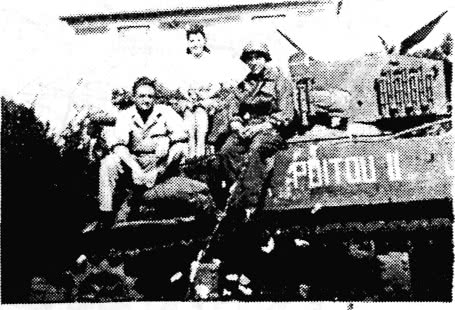
They passed the houses called “La Butte” and “Le Coudray” without incident, although they were doubtless seen by the German machine gun posts located in the valley below the. Suddenly the lead tank “ Poitou” was hit head on by a 75mm armour piercing shell from a German heavy tank hidden in the woods known locally as “Bois de Navrotte”, at the top of the hill where the “Passe Vite” joins the D19.
At almost the same time, the “Poitou” was struck in the side by a 37mm shell that hit the engine and immobilised the tank. The driver, Gaston Fievet, was killed instantly; the surviving “ Poitou” crew abandoned their tank while the supporting infantry jumped down from the halftracks to come to their aid, making their way along the cover of the hedgerows. The tank co-driver, Gilbert Gobillot, died of his injuries near the stricken tank; the gun/radio operator, Pierre Namotte, was seriously wounded and evacuated to the American hospital at Yvre l’Eveque; and the fourth crew member, the tank commander, Dante Cerruti, escaped uninjured (pictured left above).
The French foot soldiers engaged with German infantry and machine guns in the valley below the “Passe Vite”, just south of the farm “La Christophière”; a dozen French infantrymen were wounded, two seriously (Sgt Pastourel and Private Medina). Despite the ongoing gunfire, a young girl, Rachel Saillant, came from the farm “Le Coudray” with dressings and a bottle of eau-de-vie to comfort the wounded.
Eventually the “Passe Vite” was secured, and French machine gun and anti-tank gun posts were established on the hillside above Ancinnes.
In the meantime, the two remaining light tanks and the halftracks from the advance party, their passage being blocked by the “Poitou”, had gingerly reversed back to the crossroads with the road from Ancinette and turned downhill to try an alternative approach to Ancinnes from the south. A platoon of medium Sherman tanks, led by Lt Truchis, took the lead on this approach to Ancinnes.
The French armoured column was ambushed again, this time at a turn in the road at the farm called “Le Fresne”; it came under fire from German anti-tank artillery hidden up the road near “Le Chesnay”, where the road joined with the D108 from Ancinnes to Bourg le Roi. Artillery fire was exchanged for an hour but no further ground was gained by the French.
A reconnaissance party of 3 infantrymen was despatched by Cne Rogier in order to determine the exact disposition of the German guns hidden on this southern approach to the village. As they approached the village on foot, creeping along the hedgerow, the party came under enemy machine gun fire at point blank range, the Germans being hidden in a ditch and partly covered by a hedge. Two of the unfortunate French soldiers were killed (Warrant Officer 1st class Léon Pagnoux and WO Dominique Missoffe), but the third (Private Taburet) managed to escape despite being wounded. The dead soldiers were later that night buried in the garden of the farm “ Geneslay”, where a memorial to them and the dead crew of the "Poitou" was erected in 1982.
The Memorial at "le Geneslay"
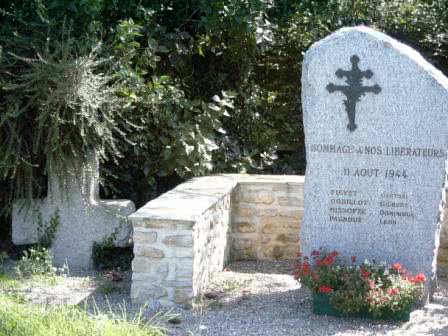
By 18.00h the French armour was still pinned down at the bend in the road a kilometre from the village centre. To break the German defences, the French forces called for American air support.
Also fearing a possible counterattack from the German armour near “Montguillon” to the east, or from the forces still present and active around “Montregnier”, a tank platoon was ordered into defensive positions to the east. At this same time, a separate column of the 2DB was advancing from Louvigny towards “ Aubépine” on the D19 and the nearby farm of “Montregnier” on the plateau above Ancinnes, in order to prevent the remaining German armour in the forest of Perseigne from cutting between the flanks of the two advancing Allied columns.
It was at this point that the village priest, Abbé Luçon, appeared before the astonished French officers of Cdt Massu, having crossed no-man’s land from the village. He was able to reveal the exact position of the key German defences so that the French could pinpoint their artillery fire.
A “commando” raid was organised using infantry of 6th Company armed with smoke and incendiary grenades; they approached the western edge of the village under cover of a dry stream bed which ran from Ancinnes into the Semelle; their task was partly diversionary, and partly to attack with their incendiaries any German armour encountered on the village outskirts.
At about 19.00h several fires were observed to break out to the south of the village – possibly property caught alight under the continuing artillery bombardment, or German positions under attack from the “commandoes”, of whose progress there was no further news at this point. In any case, the French forward command decided that this was the moment to make a push for the village, as there was still no news of possible air support.
A medium (Sherman) tank platoon under Lt Rives undertook the assault, supported by infantry.
The three tanks “ Iseran”, “Savoie” and “Valserine” made rapid progress towards the village, under cover of heavy shellfire raining down on the presumed German positions near “Le Chesnay”, the home of M Mme Léonce Barre. Believing that there could be enemy tanks hidden behind this house, the commander of the lead tank “ Iseran”, MdL Pierre Forest, fired three 75mm rounds through the walls of a house called “Le Chesnay” and in so doing destroyed two German armoured track gun carriers equipped with 37mm anti-tank guns, hidden behind the building on the road to Bourg le Roi.
German guns destroyed at “le Chesnay”
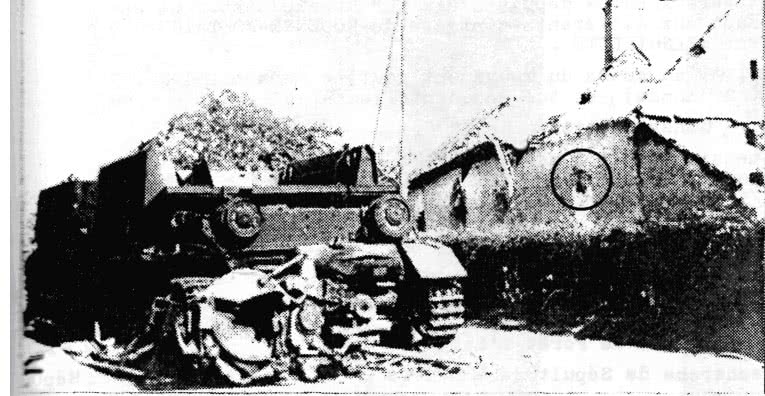
The same spot in 2007

Turning right, towards the village centre, the tank “Savoie” of Lt Rives took the lead but was hit by two lance-grenades (panzerfaust, rocket grenades) fired from one of numerous German machine gun nests in the buildings at the main crossroads. These took out the gun turret and wounded Lt Rives and Robert Montagne, the tank commander and the radio man. The tank could still move and reversed out of further danger under covering fire from the tank “Iseran”, while the 6th Company Infantry also engaged the enemy positions at the main crossroads in the village centre.
The “Iseran” and crew Lebegue, Jeanteau, Tiercelin, Forest with a 5th man Guichard (right)
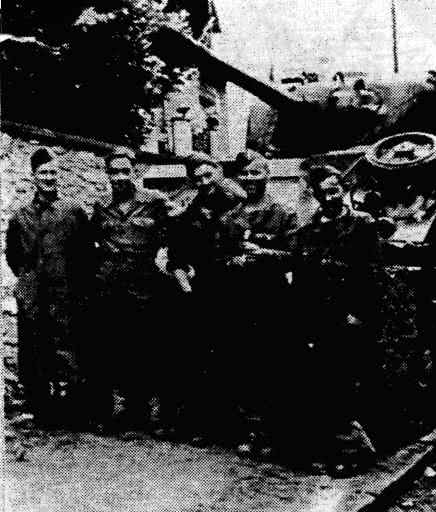
Jeanteau, Tiercelin, Lebegue and Forest next to the "Iseran" Sherman tank

Despite wounds to his legs and face, Lt Rives took over command of the tank “Valserine” and once more led the attack into the village centre, passing the damaged “Savoie”. During this attack, the “ Valserine” destroyed an armoured car equipped with two 50mm anti-tank canon, hidden in the courtyard of a house.
The French tanks now decided to withdraw a hundred metres to wait for adequate infantry support. Once this arrived, they advanced once more into the village centre. A second German armoured car was destroyed by a bazooka of the 6th Company RMT, and a German half-track SdK 251 armed with a 75mm gun was destroyed by the “Valserine”, next to the barn of Mme. Juliette Moreau, 8 rue de la Libération.
SdK 251 hit by the “Valserine” at 8 rue de la Libération

The same spot in 2007
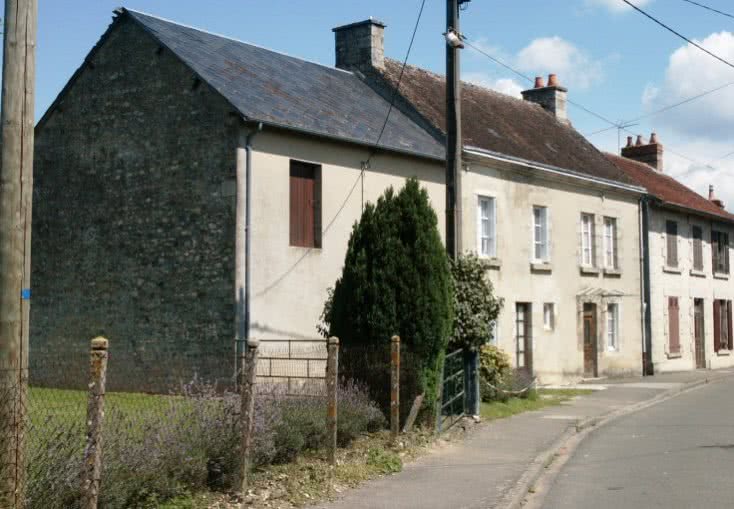
The column awaited further infantry support before advancing a third time. German resistance was stubborn but the third attack took most of the northern part of the village, following which the infantry went from house to house to dislodge isolated German foot soldiers. During this final push, another German halftrack with canon was destroyed by a French tank near the old Mairie at the north end of the village, which incidentally led to two barns catching fire. A munitions truck was also blown up by French tank fire at the north of the village near “les Guillebaudières”.
The Germans gradually withdrew up the forest road towards “la Louverie” on the forest edge and the outskirts of the village. Enemy fire continued to hit the French positions in the village late into the evening. The area near the farm “le Vaubézon” to the east of Ancinnes was not finally abandoned by the Germans until 3.00am on the 12th August. The French forces finally bivouacked at various points in and around the village.
The following day, Leclerc's 2.D.B. would advance and liberate Alençon, from which the Germans had already withdrawn northwards, into the Forest of Ecouves.
French losses in the liberation of Ancinnes were:
- 2 dead (Gilbert Gobillot, Gaston Fievet)
- 5 wounded
- 1 light tank destroyed (“ Poitou”)
- 1 medium (Sherman) tank out of effective action (“ Savoie”)
- 2 dead (Léon Pagnoux, Dominique Missoffe)
- 3 seriously wounded (Sgt Pastourel, Privates Medina and Caburet)
- 15 other wounded
Grave of Léon Pagnoux in Ancinnes Cemetery
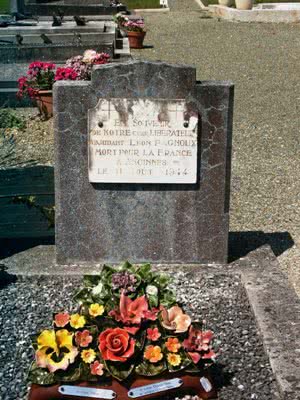
Grave of Gaston Fievet in Ancinnes Cemetery
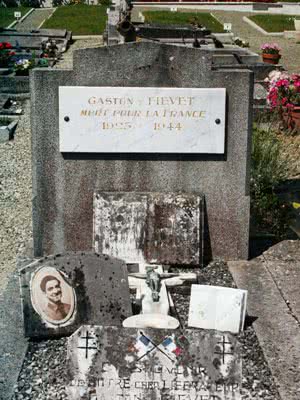
In addition to the loss of material described above, the German defenders lost 9 men killed in action and 77 taken prisoner. Material losses were:
- 2 armoured tracked guns with 37mm canons destroyed by the "Iseran" near “le Chesnay”
- 1 armoured car on fitted with 2x50mm anti-tank canons, destroyed in a courtyard in the village centre by the "Valserine"
- 1 half-track SdK 251 with 75mm gun on the D108 (8 rue de la Libération) destroyed by the "Valserine"
- 1 armoured car destroyed by by bazooka of the 6th Company R.M.T.
- 1 armoured car fitted with a canon destroyed by a tank near the old Mairie at the north of the village
- 1 munitions wagon hit by a tank near “les Guillebaudières”
- 1 car broken down and abandoned near “le Montguillon”
- 1 car abandoned and burned near “le Berry”
- 1 petrol tanker lorry broken down and abandoned on the D19 south of “l’Oisellerie”
- 1 petrol tanker lorry destroyed by aircraft fire on the D19 south west of “l’Oisellerie”
Grave of the Poirier Family in Ancinnes Cemetery

There was also a number of civilian casualties and mortalities; between 17.00h and 18.00h on 11th August 1944, four members of the Poirier family, the father and three children aged 2, 13 and 15, refugees from St Germain-du-Corbéis, were killed by a shell which exploded near them as they took refuge in a sunken lane near “les Guillebaudières”. A fifth civilian, Marie Huet, was killed in the same incident. Four civilians were also wounded - Mmes Fernande Defaux, Marcelle Gautier, Ida Brière and Adelaide Courard.
Monument to the Dead of the 2ème D.B. at the side of the RN138/D338 south of "Fyè"
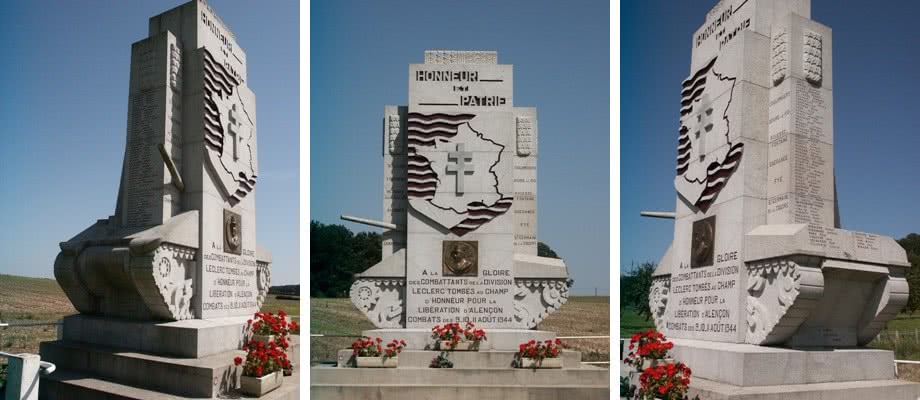
Bibliography
- La 2ème D.B. dans le "Saosnois" Fascicule No. 6; Alexandre AUBRY. Tirage limité 1990
- La Libération de la Sarthe par les gars du Général Leclerc; Jacques Morize. Dupli-Print, août 2006
- Histoire de la Résistance, Série "Que sais-je" No. 429; Henri Michel. Presses Universitaires de France, 1950.
- From the Sarthe Departmental Archives at Le Mans:
- statement of André Malo made on the 50th anniversary of the liberation of Ancinnes, 1994;
- contemporary statement of Captain Tournemire of the Mamers Police concerning the German police raid on Ancinnes;
- article in "Le Maine Libre" dated 14 December, 1944 concerning the trial of René Rollet;
- statement of Julien Collet, gendarme and resistance member at Coulans;
- Commission d'Histoire de l'Occupation et de la Libération de la France (CHOLF) documents summarising the activity of various Sarthe resistance members.
